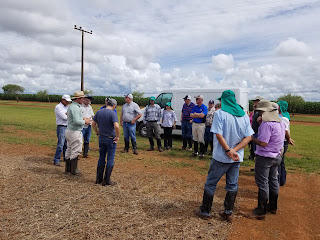We started with a visit to the SLC group, one of the largest agricultural groups in Brazil, in the Pamplona farm. This was one of fifteen locations they have in Brazil. This location consisted 48,696 acres with 20,400 acres of soybeans. They have 320 acres of research with 47 trials and test 167 varieties each year to select about 11 that they will grow each year.
They measure production costs in bags of soybeans per hectare, which is roughly equivalent to bushels per acre. They estimate a fixed and variable cost of 37 bags per hectare. We observed them harvesting with 6 combines in one seed field that averaged about 58 bags per hectare. They use combines for about 7000 hours before trading them in. They have a close relationship with John Deere. We observed technicians estimating populations, harvest loss and diseases while they were combining.
Key production issues they face include white mold, soybean rust, stinkbugs, caterpillars like Helicoverpa armigera. They make 6-7 applications of insecticides and fungicides. They are using an increasing amount of biologicals like Trichoderma harzianum for white mold management. They are also using Fluazinam to help control white mold. We also learned that they have a 90 day sanitary period when they are not allowed to plant soybeans to help prevent soybean rust development.
At the second stop we visited a farm where yields had stagnated and they have initiated some advanced soil management techniques to improve soil quality and improve soybean yields. In some of their irrigated center pivots, they changed from a traditional soybean/corn rotation to corn interseeded with brachyaria to establish a grass for four months to two years prior to planting soybeans again.
We observed one field of 700 head of cattle being backgrounded on the grass. This results in improved soil health and fewer soil borne diseases. Nematodes and herbicide resistant weeds are also a pest in the area that are helped with this practice.
They are starting to diversify with grapes and persimmons grown next to the soybeans. They dont have the RR Extend soybeans in Brazil however they do have a Bt soybean called Intacta.









 Because of the nutrient savings they were able to suspend fertilizer applications for five years following a drought and this had a significant economic impact.
Because of the nutrient savings they were able to suspend fertilizer applications for five years following a drought and this had a significant economic impact.

 We reviewed the
critical need for IPM, importance of roots and straw in no-till Brazilian soybean production. We also learned about inoculant use here and
some of the new combinations that they are working with.
We reviewed the
critical need for IPM, importance of roots and straw in no-till Brazilian soybean production. We also learned about inoculant use here and
some of the new combinations that they are working with.
















